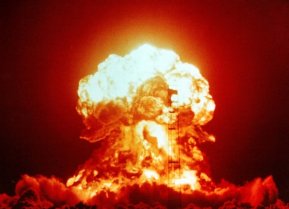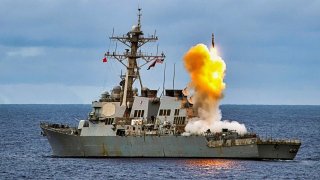China Has 100,000 Naval Mines to Sink the U.S. Navy in a War
A less well-known tactic in China’s toolbox is the use of undersea mines (perhaps as many as 100,000) to keep the U.S. Navy fleet guessing about where they can deploy safely without striking a mine.
When you think of undersea warfare, you immediately conjure up images of submarines, particularly in the Indo-Pacific. China and the United States have significant numbers of subs patrolling in those waters daily. But a less well-known tactic in China’s toolbox is the use of undersea mines (perhaps as many as 100,000) to keep the U.S. Navy fleet guessing about where they can deploy safely without striking a mine.
The U.S. Naval War College contends the use of mines by the Chinese navy as part of its “Assassin’s Mace” strategy which is to hit asymmetrically against the American fleet.
China Is Rehearsing Mine Warfare
Since at least 2021, China has conducted exercises in which it has laid mines dropped from its H-6J bombers in the South China Sea near Hainan Island – the southernmost region of China. In 2018, the People’s Liberation Army Navy (PLAN) engaged in a drill with 60 minelayers and minesweepers in the South China Sea to protect various islands, rocks, and reefs where Beijing has territorial claims.
The PLAN has emphasized that mine-laying is a key feature of its undersea warfare strategy.
Heavy Duty Use of Assassin’s Mace Stratagem
The Assassin’s Mace strategy aims to keep the U.S. Navy from having access to certain waters and denying the Americans ability to sail close to the mainland. This is called anti-access / area denial and it is a critical technique to protect PLAN assets.
Taiwan Is Key
The Chinese could also lay mines near Taiwan and Japan to again promote its Assassin’s Mace and anti-access area denial strategies. Yusuhiro Kawakami is a Senior Fellow at the Sasakawa Peace Foundation in Japan. Kawakami is an undersea warfare expert who specializes in mine warfare. Kawakami believes China could lay mines on the west and north side of Taiwan to menace Taiwanese shipping and create means to blockade the island and deny naval and civilian ships freedom of maneuver.
Moreover, countries supporting Taiwan in a Chinese attack such as the United States, Japan, and Australia could be denied the opportunity to sail close to Taiwan. But Kawakami believes the Taiwanese could turn the tables and lay their own mines to protect coastlines against the potential amphibious invasion from China.
Japan and the United States Are Teaming Up
The United States has worked with Japan in annual undersea mine exercises for decades. In 2021, both navies practiced scenarios that simulated and intensified the danger of mines laid by the Chinese. U.S. Navy minesweepers USS Patriot (MCM 7), USS Pioneer (MCM 9), USS Warrior (MCM 10), and USS Chief (MCM 14) participated in the drills off the coast of northern Japan.
China Sinks Its Teeth Into Mine Warfare
China believes that minelaying is cheap and easy to accomplish. Mines can be concealed readily and have ample destructive power. The PLAN thinks the United States is not well-trained on minesweeping and does not make it a priority.
But What If the Americans Lay Mines In Chinese Waters?
One American who does ponder mine warfare to a great extent is naval officer Victor Duenow. Duenow believes the U.S. Navy should lay its own mines and pursue anti-access area-denial against the Chinese. Duenow thinks the Americans could engage in offensive mine laying in the Yellow Sea and Pearl River Delta to thwart Chinese commercial and PLAN shipping should warfare ever commence between China and the United States. Duenow wrote that this would be a decisive blow against the Chinese economy should the Americans lay mines in those areas. China has poor minesweeping capabilities, according to Duenow.

Mine warfare between China and the United States and its allies is one aspect of war to be analyzed. However, it is less likely to dominate a conflict like submarines, anti-ship missiles, airplanes and bombers. To be sure, it is an aspect of undersea warfare that is often overlooked.
The PLAN and the U.S. Navy are always looking for tactics, techniques, and strategies that can tip the balance in favor of one side or the other. The use of sea mines due to their inexpensive nature and ease of use could be a factor in a future conflict. The most likely scenario is their use around Taiwan in a PLAN blockade of the island. It will be up to the Americans, Australians, Taiwanese, and Japanese to continue to prepare for this contingency.
Expert Biography
Dr. Brent M. Eastwood is the author of Humans, Machines, and Data: Future Trends in Warfare. He is an Emerging Threats expert and former U.S. Army Infantry officer. You can follow him on Twitter @BMEastwood. He holds a Ph.D. in Political Science and Foreign Policy/ International Relations.
All images are Creative Commons.


